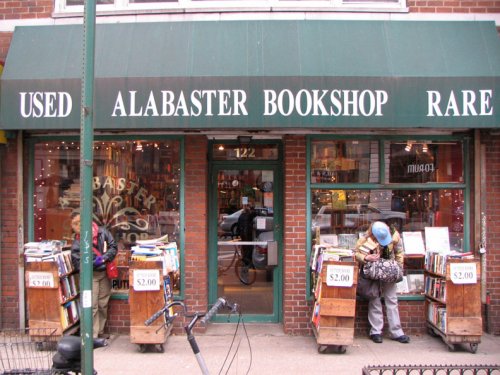Alabaster Bookshop & the Bibliographic Legacy of Fourth Avenue


In honor of Small Business Week, we’re delving into the history of Alabaster Books, at 122 Fourth Avenue. Alabaster Books shines as a cultural remnant of Fourth Avenue Book Row and of bookselling in New York City. It continues to provide its patrons and New York with a wide range of wonderful books, both new and used.
As we’ve already described in previous Off the Grid posts, the area between Astor Place and Union Square was a hub of secondhand and rare bookstores starting in the 1890s. The seven blocks along Fourth Avenue were known as New York Booksellers’ Row, or “Book Row,” colloquially.

With the Strand as an obvious outlier, most booksellers on Book Row closed shop or relocated by the late 1960s. Several Fourth Avenue vendors banded together to form the Fourth Avenue Booksellers Association with a headquarters at 73 Fourth Avenue. In 1969, they requested to change the street signs between Eighth and Fourteenth Streets to say “Fourth Avenue Book Row,” but their request was denied.
The original bookstores of Book Row included Argosy Book Store, Atlantis, Biblo & Tannen, J.R. Brussel Book Shop, Louis Schucman Bookseller, Ortelius, Pelican Book Shop , The Strand Bookstore, Weiser Antiquarian Books , University Place Book Shop.
In Jim Epstein’s 2011 short documentary film Book Row: The history of the Strand Bookstore with Fran Lebowitz, Marvin Mondlind, the estate book buyer for The Strand, said, “The sort of thing that goes on now at Barnes and Nobel, where they give you service with a smile and have coffee… old Book Row people would have just scorned the whole thing. We’re selling books here, and if people don’t want old books, we don’t want them here.”
As Mondlind hints, the booksellers and bookstore owners on Book Row were fiercely protective of their stores and often idiosyncratic. Of the somewhat surly demeanors of Book Row owners, Fran Lebowitz joked, “They hated you — it was like you had broken into their house.”
“These owners did not pass wisdom on to their descendants,” said Fred Bass of the Strand. Of course increasing rents and the need for more storage space as bookstores’ collections expanded were also major contributing factors to Book Row’s demise — not to mention the proliferation of large retail bookstores like Barnes & Noble.

Nevertheless, Alabaster Bookshop is still going strong today as the last of the secondhand bookstores that once made up Fourth Avenue’s Book Row. Though it’s steps away from The Strand, it has managed to thrive in its own right since its opening in 1996. Two dollar hardcovers and paperbacks fill the rolling carts outside the store, while the selection inside is eclectic, featuring rare photography and art books and first edition paperbacks and poetry collections.

Steve Crowley opened Alabaster Bookshop at 122 Fourth Avenue in 1996. The New York Times wrote in 1997: “Mr. Crowley… has the advantage of learning from a strong mentor. He came to New York in 1986 as a drummer, playing with underground bands in places like CBGB but paid the rent by working on and off at the Gryphon Bookshop on Broadway and 80th Street, where one of the owners was Henry Holman.” (Holman was also the founder of the legendary Westsider Books and Records on the Upper West Side).
Crowley dreamt of opening up his own bookstore on his regular bike rides along Fourth Avenue, as he commuted to Gryphon Bookshop from his Lower East Side walk-up. “On one trip uptown last summer,” reported the same Times journalist in 1997, “he spotted a for-lease sign in the window of the old Abbey Bookshop, which had fallen into disrepair. Its owner, George Foss, died last year. Mr. Crowley saw potential in the place and persuaded an uncle to lend him $15,000 to get started.”
*
On a sunny weekday afternoon at Alabaster Books in April, the store is crowded with curious individuals and small groups browsing fine photography books, small-press poetry volumes, and much more. Their recent additions, as catalogued on their instagram, include “Black Against Empire: The History and the Politics of the Black Panther Party,” a signed copy of R. Crumb’s “The Book of Genesis Illustrated,” and a catalogue of the Paintings of Joan Mitchell.

*
Even despite its quirks, the Fourth Ave Book Row was a haven for lovers of the written word. The NYC-based poet Eli Siegel, who William Carlos Williams once referred to as “the very first rank of our living artists,” wrote a poem called “Hymn to Fourth Avenue.” The piece conveys the aura of creativity and inspiration that Book Row offered, and which Alabaster continues to offer, to generations of writers and literature enthusiasts:
“Ah, all the books waiting for you
In the crowded bookshops of Fourth Avenue.
Experiences galore;
Experiences you’ll adore.
Bibliographical thrills
New as the hills
Mental fountains,
Emotional mountains.
In books, you’ll find what you are looking for.
In books is that which makes existence more.
Our hopes in life are often in an old book store.”
*
The Area South of Union Square
The remarkable Alabaster Bookshop, as well as the sites of all former bookshops of Book Row, are located in the area south of Union Square, a historic neighborhood today facing threats of demolition and out-of-scale new development. Village Preservation is leading an effort to secure landmark protections: click here to learn more about this historic neighborhood and our campaign and here to call upon city officials to support landmark designation.
